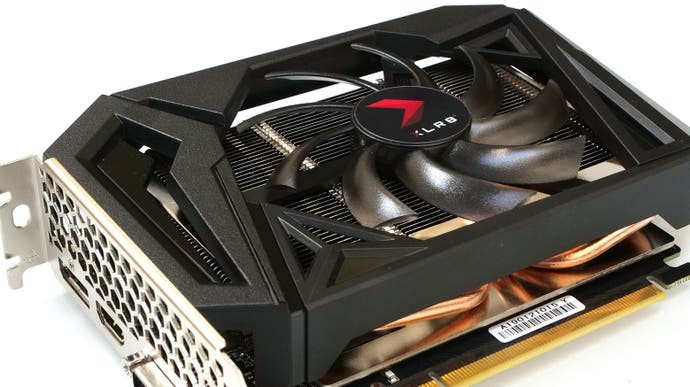Nvidia GeForce GTX 1660 Ti review: the new 1080p champion?
No ray tracing, but great performance for the price.
Nvidia's Turing roll-out continues with the arrival of its first sub-£300/$300 graphics card - the GeForce GTX 1660 Ti. And yes, that's GTX rather than RTX with Team Green opting to remove hardware-accelerated ray tracing and machine learning features from its cheaper range of GPUs. It is still Turing, however, using the same revised shader modules offering enhanced performance and increased power efficiency. Priced at £259/$279, GTX 1660 Ti is a direct replacement for GTX 1060, delivering a substantial increase in gaming frame-rates, often exceeding the power of the outgoing GTX 1070.
And that level of performance is a crucial one. Back in 2015, Nvidia launched the Titan X Maxwell - a 'big chip' monster that delivered hitherto unheard of graphics power. GTX 980 Ti followed, with very similar frame-rates delivered by the still-capable GTX 1070 a year later. Now, in 2019, GTX 1660 Ti brings that level of power below the £300/$300 threshold, its 120W TDP less than half that of the GTX 980 Ti.
And that level of efficiency explains the form-factor seen in many of the GTX 1660 Ti models available, including the PNY XLR8 model we're reviewing today. Our review card is a small form-factor offering, with a lightweight heatsink and just a single fan. There's no real premium finish here - there's a basic plastic shroud, for starters - so there's a distinct lack of higher-end features like RGB lighting, but this is what I like to see from a value-orientated release. The XLR8 is a basic, honest design that delivers performance and saves money. In the case of the XLR8, the only issue I have with it is the slightly loud fan noise. Beyond that, I really like the dinky form factor, ensuring it's an easy fit in most PC cases.
In terms of inputs and outputs, power is supplied via an eight-pin PCIe Express socket, while HDMI 2.0, dual-link DVI and DisplayPort deliver support for pretty much every kind of monitor out there. The USB-C VirtualLink socket from the upper range Turing cards is absent, but I'd venture to suggest that it won't be missed at this price-point - even though the GTX 1660 Ti very comfortably exceeds the base spec for VR support.
| GTX 1060 | GTX 1070 | GTX 1660 Ti | RTX 2060 | RTX 2070 | |
|---|---|---|---|---|---|
| CUDA cores | 1280 | 1920 | 1536 | 1920 | 2304 |
| VRAM | 6GB GDDR5 | 8GB GDDR6 | 6GB GDDR6 | 6GB GDDR6 | 8GB GDDR6 |
| Memory Bus | 192-bit | 256-bit | 192-bit | 192-bit | 256-bit |
| Bandwidth | 192GB/s | 256GB/s | 288GB/s | 336GB/s | 448GB/s |
| Boost Clock | 1708MHz | 1683MHz | 1770MHz | 1680MHz | 1620MHz |
| Processor | GP106 | GP104 | TU116 | TU106 | TU106 |
| TDP | 120W | 150W | 120W | 160W | 185W |
At the silicon level, GTX 1660 Ti is fascinating as it features the debut of another bespoke Nvidia processor - TU116 - the first Turing processor to arrive without RT or Tensor cores. Based on 24 shader modules for a total of 1536 CUDA cores, it's built on the 12nmFF process and uses 6.6 billion transistors, a straight increase of 50 per cent over GTX 1060's 4.4 billion. It's paired with six gigabytes of GDDR6 memory, with modules running at 12gbps. This delivers 288GB/s of bandwidth over a 192-bit bus - another impressive upgrade over the outgoing GTX 1060. While it may lack the ray tracing and AI features of the other Turing cards, enhancements like variable rate shading (currently available only on Wolfenstein: The New Colossus) are still available, which may have a key role to play in more titles going forward.
Nvidia is aiming the GTX 1660 Ti at those looking for best-in-class 1080p performance, and at its £259/$279 price-point, it is undoubtedly more expensive than the £240/$250 GTX 1060, and indeed AMD's current 1080p champions, RX 580 and RX 590. However, as you'll see from the benchmarks, the performance uplift offered by Nvidia's new card is substantial. By delivering performance more in line with GTX 1070, it does deliver value and isn't a million miles away from the throughput delivered by a stock RX Vega 56.
It's almost as if Nvidia is looking to carve out a new price niche here - premium 1080p gaming that sits between RX 590 and Vega 56, presumably opening the door to a non-Ti version of the 1660 using a cut-down version of the TU116 processor a little further down the road. But with pricing at a 'tweener' position, we'll be concentrating our benchmarks on both the existing 'go to' cards for 1080p gaming, and the more premium end occupied by Vega 56, RTX 2060 and the outgoing GTX 1070.
There's one more thing to cover before we begin a more detailed performance analysis. There is a reference specification for the GTX 1660 Ti, but there are no reference cards, so you should expect a small degree of variance in frame-rate between different models as board manufacturers add their own factory overclocks. The PNY XLR8 card adds a minor +45MHz to the core - unlikely to have a noticeable improvement on game performance, but it is one of the cheaper offerings and so it is representative of the performance you'll get without having to spend a premium on a higher-end version of the product. With that out of the way, let's get testing.
Nvidia GeForce RTX 1660 Ti Analysis
- Introduction, Hardware Breakdown [This Page]
- Assassin's Creed Odyssey/Unity, Battlefield 1 - Performance Analysis Part 1
- Crysis 3, Far Cry 5, Ghost Recon Wildlands - Performance Analysis Part 2
- Rise of the Tomb Raider, Shadow of the Tomb Raider, The Witcher 3 - Performance Analysis Part 3
- Nvidia GeForce GTX 1660 Ti - the Digital Foundry verdict





